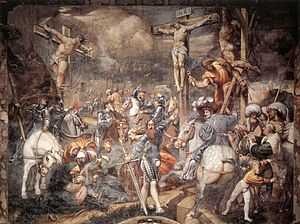Il Pordenone
| Il Pordenone | |
|---|---|
|
Bust of Il Pordenone. Castle of Udine. | |
| Born |
Giovanni Antonio de’ Sacchis circa 1484 Pordenone |
| Died |
1539 Ferrara |
| Nationality | Italian |
| Known for | Painting |
| Movement | Italian Renaissance |
Il Pordenone, byname of Giovanni Antonio de’ Sacchis (c. 1484–1539), was an Italian painter of the Venetian school, active during the Renaissance. Vasari, his main biographer, wrongly identifies him as Giovanni Antonio Licinio.
Biography
His name derives from being born in Pordenone, even if his family came from Corticelle (Brescia, Lombardy). He ultimately dropped the name of de’ Sacchis, having quarrelled with his brother Bartolomeo, who had wounded him in the hand. He then called himself Regillo, or De Regillo. His signature runs Antonius Portusnaonensis, or De Portunaonis. He was knighted as a cavaliere by the king of Hungary John Zápolya.
As a painter, Pordenone was a scholar of Pellegrino da San Daniele, but a leading influence of his style was Giorgione; the popular story that he was a fellow-pupil with Titian under Giovanni Bellini is false. It was claimed that Pordenone’s first commission was given him by a grocer in his home town, to try his boast that he could paint a picture as the priest commenced High Mass, and complete it by the time Mass was over; he completed the picture in the required time.[1] The district about Pordenone had been somewhat fertile in capable painters; but Pordenone is the best known, a vigorous chiaroscurist and flesh painter. The 1911 Britannica states that "so far as mere flesh-painting is concerned he was barely inferior to Titian in breadth, pulpiness and tone". The two were rivals for a time, and Giovanni Antonio would sometimes affect to wear arms while he was painting. He excelled in portraits; he was equally at home in fresco and in oil-color. He executed many works in Pordenone and elsewhere in Friuli, Cremona, and Venice; at one time he settled in Piacenza, where one of his most celebrated church pictures, St. Catherine disputing with the Doctors in Alexandria is located. The figure of St. Roch, in the Dome of Pordenone is considered his own portrait.

He was invited by Duke Ercole II of Ferrara to court; here soon afterwards, in 1539, he died, not without suspicion of poison committed by Titian. His later works are comparatively careless and superficial; and generally he is better in male figures than in female-the latter being somewhat too sturdy-and the composition of his subject-pictures is scarcely on a level with their other merits. Pordenone appears to have been a vehement self-asserting man, to which his style as a painter corresponds.
Three of his principal pupils were Bernardino Licinio, named Il Sacchiense, his son-in-law Pomponio Amalteo, and Giovanni Maria Calderari.
| Wikimedia Commons has media related to Il Pordenone. |
Partial anthology of works
- Study of the Martyrdom of Saint Peter Martyr (1526, J. Paul Getty Museum)[2]
- Saint Bonaventure (National Gallery, London)[3]
- Saint Louis of Toulouse (National Gallery, London)[4]
- Saints Prosdocimus and St. Peter (1516, North Carolina Museum of Art, Raleigh).
- Golgotha (1520–21, fresco, Cathedral of Cremona)
- Madonna and Child Enthroned with Saints (c. 1525, Parish church, Susegana, Treviso)[5]
- St Lorenzo Giustiniani and Other Saints (1532, originally in Santa Maria dell’Orto, now Accademia, Venice)
- Madonna and Child enthroned with Saints (1525)
- Cupula Frescoes: Scenes from Old Testament, Basilica di Santa Maria di Campagna, Piacenza
- Saint Martin and Saint Christopher (1528–29, Church of San Rocco, Venice)
- San Lorenzo Giustiniani and Two Friars with Saints (1532, Galleria dell’Accademia, Florence)
- Saints Sebastian, Roch and Catherine (1535, Church of San Giovanni Elemosinario, Venice)[6]
- Madonna and Child Enthroned with Saints (1525, Parish Church, Grandcamp, France).
- The dispute of Saint Catherine with Pagan Philosophers (Cathedral of Piacenza)[7]
- Deposition and Immacolata Concezione (1530, Church of the “Annunziata”, Cortemaggiore)
- San Gottardo and Saints Sebastian and Rocco (Museo Civico d’Arte, Pordenone)
- Saint Catherine and Martyrs (Museo Civico di Conegliano)
- Drawings from Ambrosiana Library, Milan
- Magi (Treviso Cathedral)[8]
References
 This article incorporates text from a publication now in the public domain: Chisholm, Hugh, ed. (1911). Encyclopædia Britannica (11th ed.). Cambridge University Press.
This article incorporates text from a publication now in the public domain: Chisholm, Hugh, ed. (1911). Encyclopædia Britannica (11th ed.). Cambridge University Press.
- ↑ Carlo Ridolfi quoted in
 "Giovanni Antonio Pordenone". Catholic Encyclopedia. New York: Robert Appleton Company. 1913.
"Giovanni Antonio Pordenone". Catholic Encyclopedia. New York: Robert Appleton Company. 1913. - ↑ J. Paul Getty Museum. Study of the Martyrdom of Saint Peter Martyr. Retrieved 2008-08-27.
- ↑ Saint Bonaventure - From National Gallery website
- ↑ Saint Louis of Toulouse - From National Gallery website
- ↑ Opere Pittoriche Famose
- ↑ The Iconography of Saint Sebastian
- ↑ Church website
- ↑ ARGOMENTI ARTE & STORIA DELL' ARTE
|